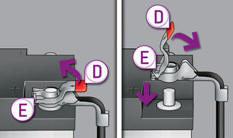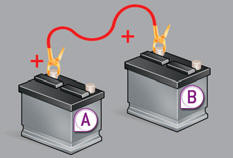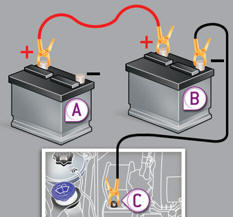12 V battery
Procedure for starting the engine using another battery or charging a discharged battery.

The presence of this label indicates the use of a 12 V lead-acid battery with special technology and specification, for which the involvement of a PEUGEOT dealer or qualified workshop is required when replacing or disconnecting the battery.
Failure to observe this recommendation may cause premature wear of the battery.
After Refitting the battery, the Stop & Start system will only be active after several hours depending on the climatic conditions and the state of charge of the battery (up to about 8 hours).
The Stop & Start battery does not have to be disconnected for charging.
Access to the battery

The battery is located under the bonnet.
To gain access to it: open the bonnet using the interior release lever, then
the exterior safety catch,
secure the bonnet stay,
remove the plastic cover on the (+) terminal,
if necessary, unclip the fusebox to remove the battery.

Disconnecting the (+) cable
Raise the locking tab D fully to release the cable terminal clamp E .
Reconnecting the (+) cable
Position the open clamp E of the cable on the positive post (+) of the battery.
Press vertically on the clamp E to position it correctly on the battery.
Lock the clamp by spreading the positioning lug and then lowering the tab D .
Do not apply excessive force on the tab as locking will not be possible if the clamp is not positioned correctly; start the procedure again.
Starting using another battery
When your vehicle's battery is discharged, the engine can be started using a slave battery (external or on another vehicle) and jump lead cables.
First check that the slave battery has a nominal voltage of 12 V and a capacity at least equal to that of the discharged battery.
Do not try to start the engine by connecting a battery charger.
Do not disconnect the (+) terminal when the engine is running.
Connect the red cable to the positive terminal (+) of the fl at battery A , then to the positive terminal (+) of the slave battery B .
Connect one end of the green or black cable to the negative terminal (-) of the slave battery B (or earth point on the other vehicle).
Connect the other end of the green or black cable to the earth point C on the broken down vehicle (or on the engine mounting).
Start the engine of the vehicle with the good battery and leave it running for a few minutes.
Operate the starter on the broken down vehicle and let the engine run If the engine does not start straight away, switch off the ignition and wait a few moments before trying again.


Wait until the engine returns to idle then disconnect the jump lead cables in the reverse order.
Charging the battery using a battery charger
Disconnect the battery from the vehicle.
Follow the instructions for use provided by the manufacturer of the charger.
Connect the battery starting with the negative terminal (-).
Check that the terminals and connectors are clean. If they are covered with sulphate (whitish or greenish deposit), remove them and clean them.

The batteries contain harmful substances such as sulphuric acid and lead.
They must be disposed of in accordance with regulations and must not, in any circumstances,
be discarded with household waste.
Take used remote control batteries and vehicle batteries to a special collection
point.
![]() It is advisable to disconnect the battery if the vehicle is to be left
unused for more than one month.
It is advisable to disconnect the battery if the vehicle is to be left
unused for more than one month.
![]() Protect your eyes and face before handling the battery.
Protect your eyes and face before handling the battery.
All operations on the battery must be carried out in a well ventilated area and
away from naked fl ames and sources of sparks, so as to avoid the risk of explosion
or fi re.
Do not try to charge a frozen battery; the battery must first be thawed out to avoid
the risk of explosion. If the battery has been frozen, before charging have it checked
by a PEUGEOT dealer or a qualified workshop who will check that the internal components
have not been damaged and the casing is not cracked, which could cause a leak of
toxic and corrosive acid.
Do not reverse the polarity and use only a 12 V charger.
Do not disconnect the terminals while the engine is running.
Do not charge the batteries without disconnecting the terminals first.
Wash your hands afterwards.
Do not push the vehicle to start the engine if you have an electronic gearbox or automatic gearbox.
Before disconnecting the battery
Wait 2 minutes after switching off the ignition before disconnecting the battery.
Close the windows and the doors before disconnecting the battery.
Following reconnection of the battery
Following reconnection of the battery, switch on the ignition and wait 1 minute before starting to permit initialisation of the electronic systems. However, if problems remain following this operation, contact a PEUGEOT dealer or a qualified workshop.
Referring to the corresponding section, you must yourself reinitialise (depending on version):
- the remote control key,
- the electric blind(s),
See also:
Locations for ISOFIX child seats (308 SW with individual rear seats)
In accordance with European Regulations, this table indicates the options for
installing ISOFIX child seats on seats in the vehicle fitted with ISOFIX mountings.
In the case of universal and semi ...
Reactivation
Press the "ECO OFF" switch again. The system is active again; this is confirmed
by the switch warning lamp going off, accompanied by a message in the screen.
The system is reactivated aut ...
Fuel tank
Capacity of the tank: approximately 60 litres.
Low fuel level
When the low fuel level is reached, this warning lamp comes on on the instrument
panel, accompanied by an audible signal and an aler ...






